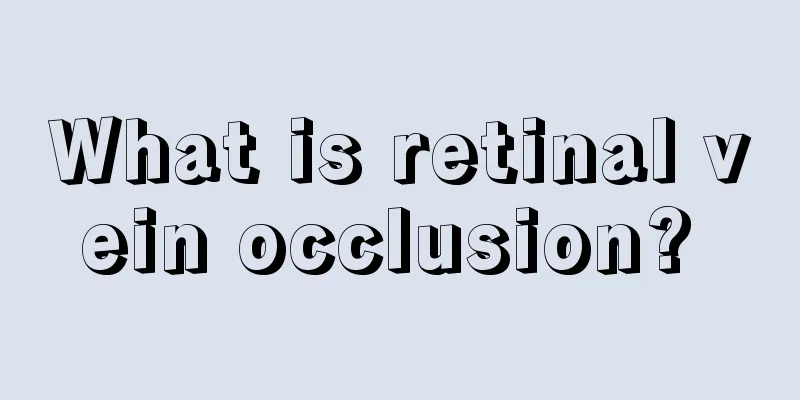What is retinal vein occlusion?

|
Retinal vein occlusion is a relatively common fundus vascular disease. Once the disease occurs, it will cause stagnation of retinal blood vessels, causing varicose veins, leading to retinal edema and hemorrhage, which is quite harmful to patients. Not only will it cause vision loss, but there is even a risk of inducing blindness. There are many causes of this disease, generally caused by multiple factors. The most common one is that the patient has hypertension, arteriosclerosis and other cardiovascular diseases, which will cause blood viscosity to thicken and cause abnormalities in blood particles, etc. In addition, trauma or oral contraceptives may cause such symptoms, which are quite harmful to patients and must be treated in time. Causes The etiology of retinal vein occlusion is complex and multifactorial. It is closely related to retinal inflammation, retinal hypoperfusion, hypertension, arteriosclerosis, high blood viscosity and abnormal hemodynamics. Trauma, oral contraceptives or excessive fatigue can all be triggers of the disease. In conclusion, retinal vein occlusion is often caused by multiple factors, including vascular abnormalities, changes in blood composition, or abnormal hemodynamics. Clinical manifestations 1. Central retinal vein occlusion (1) Mild type: also known as non-ischemic type, hyperosmotic type or partial obstruction. Subjective symptoms are mild or absent. Depending on the degree of macular damage, vision may be normal or slightly reduced, and the visual field may be normal or slightly changed. (2) Severe: Also known as ischemic, hemorrhagic or complete obstruction. ① Early stage: Most patients have blurred vision and significantly decreased vision. In severe cases, the vision is reduced to only being able to distinguish the fingers or hand movements. Those with combined arterial blockage may only have light perception. 2. Hemi-retinal vein occlusion During the development of retinal blood vessels, the hyaloid artery passes through the embryonic fissure and enters the optic cup. When the embryo is 3 months old, two veins appear on both sides of the artery and enter the optic nerve. In normal people, they merge into the central retinal vein in the optic nerve behind the optic disc. 3. Branch retinal vein occlusion (1) Early stage: The severity of visual impairment varies depending on whether the pressure point is located on the main vein or a small branch. If the blockage is located in the main trunk and macular branches, the vision will be reduced to varying degrees. If the branches that do not supply the macula are blocked, the vision may not be affected, but the visual field will have changes corresponding to the damaged area of the retina. Fundus examination often shows that the retinal arteries are thinner and have sclerotic changes. (2) Late stage: Usually about 6 months after the onset of the disease, the bleeding is gradually absorbed, the edema subsides, and star-shaped or irregular dot-shaped hard exudates appear in the macular area of the optic disc or there are ring-shaped exudates on the temporal side of the macula. This exudate is absorbed more slowly. Macular edema resolves, leaving behind a pigmentary disorder or cystic scar. The accompanying artery develops secondary sclerosis, with the diameter of the artery narrowing and a white sheath accompanying it. |
<<: What should I do if my bone marrow hematopoietic function is weak?
>>: What are the symptoms of Neisseria meningitidis?
Recommend
What are some tips in life
Life is full of surprises. A small item or a litt...
Is itchy neck a sign of lymphoma? Three things to look at
For patients with lymphoma, if it is lymphoma, it...
Is nickel harmful to the body?
Nickel is a metal element and also a siderophilic...
What are the early symptoms of hamartoma
Hamartoma is a terrible disease, but many people ...
How do patients with lymphoma receive surgery and radiotherapy
Patients with lymphoma under the age of 50 can ac...
Does an 80-year-old with breast cancer still need treatment?
Breast cancer at the age of 80 still needs treatm...
Can gastric bleeding cause constipation?
Gastric bleeding is a disease that poses a relati...
What causes black tongue coating
Black tongue coating can be said to be a symptom....
Eating bird's nest for red blood
The occurrence of red blood streaks is related to...
Is cactus poisonous?
Everyone is familiar with cactus. In the office, ...
The late symptoms of gallbladder cancer cannot be ignored!
If gallbladder cancer is not treated early, it wi...
Bone cancer can be diagnosed from the density of tumor tissue
Bone cancer can be diagnosed by the density of tu...
When is breast cancer considered advanced?
When is breast cancer considered advanced? 1. Bre...
What are the treatments for snake bites?
When people travel, they sometimes encounter snak...
Popcorn Calories_Old Fashioned Popcorn Calories
Popcorn is very popular in modern life because th...









